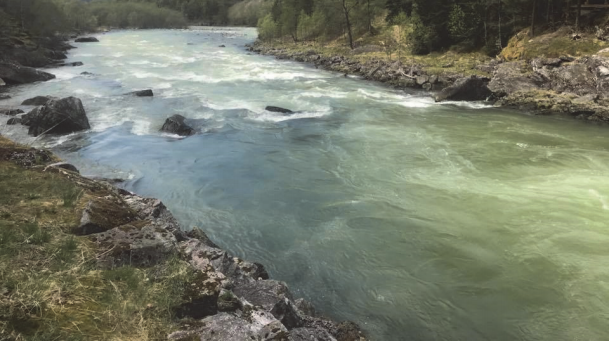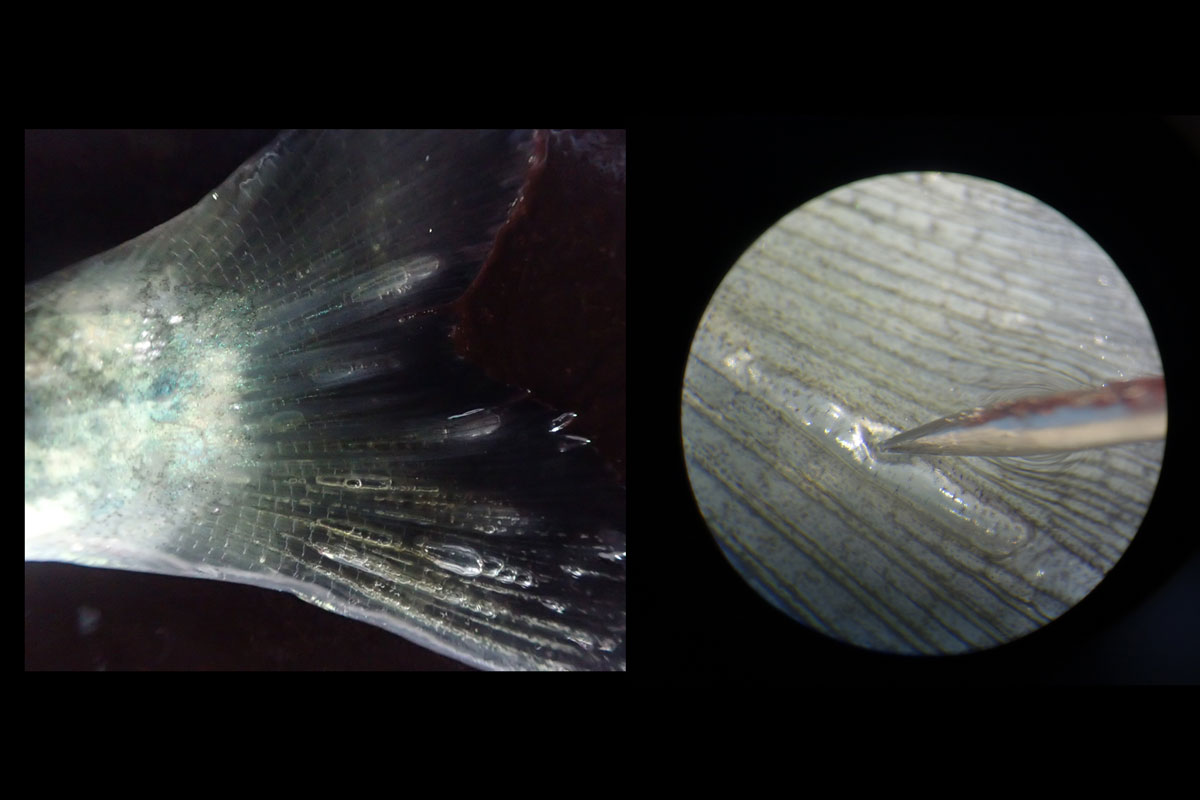Ultrasound creates pressure waves in the water, causing bubbes to form, gather, and rise to the surface. Ph.D candidate W. Ludwig Kuhn has tested a method that can be used in rivers with hydropower to prevent fish from experiencing "diver's sickness" downstream from power plants. Photo: Juliet Landrø/HydroCen.
Ultrasound in Hydropower Can Save Fish in Rivers
Shooting sound waves through water can eliminate gas bubbles that harm wildlife in rivers with power production. Researchers have explored various methods in the laboratory, and now they’re ready to test the best one on a large scale in actual power plants.
The phenomenon of total dissolved gas (TDG) supersaturation occurs when air enters the tunnel in a power plant and is subsequently subjected to high pressure.
When released into the river, it is like popping a champagne cork, bubbles shoot into the river. This introduces so much air into the water that fish and other species can be harmed. In the worst case, they can suffer from lethal gas bubble disease — similar to human diver's sickness.
Currently, there are no requirements to monitor and limit total dissolved gas supersaturation downstream from power plants in Norway. However, studies have indicated that this problem might affect many more power plants than previously thought.
If future regulations demand addressing this issue, this solution could help power companies avoid costly shutdowns of power plants when the problem arises, while also improving the environment

This is what the river looks like when the water is oversaturated with gas. This is the Ekso River with cloudy water during a gas oversaturation episode on May 12, 2018 (Photo: Eirik S. Normann, NORCE LFI)
A «Speaker» Generates Ultrasound
Researchers in the DeGas-project conducted experiments with ultrasound in a specially built multi-purpose flume at the Waterpower Laboratory at NTNU. The technical solution involves "speaker" that generates ultrasound. It creates pressure waves in the water, causing dissolved gas molecules to gather and form bubbles (acoustic cavitation). These bubbles gather, grow larger, and rise to the surface. The method has been tested on a small and medium scale in the laboratory, and W. Ludwig Kuhn demonstrates in his doctoral thesis that the method immediately reduces gas supersaturation.
Video: In this video, the researchers have created microbubbles in a specially built multi-purpose flume at the Waterpower Laboratory at NTNU. It demonstrates how sound creates pressure waves in the water, causing bubbles to cluster, grow, and rise to the surface. Photo: Juliet Landrø/HydroCen
Cooperation has led to Useful Results
Cooperation with the power industry and biologists has been crucial in executing the project. Nature researchers have contributed vital knowledge about the consequences and extent of gas supersaturation, and it has been significant to discuss various solutions along the way with industry experts.
–Initially, we thought about placing the ultrasound technology at the outlet of the turbine, says Kuhn.
–However, this idea wasn’t well received by the industry since installing it so close to the turbine posed too great a risk. They feared it might affect water flow and consequently impact other parts of the power plant.
–Hence, the conclusion is that it should be positioned in the river at the outlet of the power plant, he says.
Great Interest in the Experiments
There has been a significant flow of visitors eager to observe the experiments conducted by Kuhn in the DeGas project, which is affiliated with the research center HydroCen.
– It has been fun to show the experiments to collaborators from both research and industry. Even the Minister of Energy has visited us here. It's highly beneficial to receive input from various perspectives, says Kuhn.

Small bubbles from gas bubble disease are visible in the tail fin of this salmon. (Photo: Sondre Kvalsvik Stenberg, NORCE LFI).
Large Scale Testing in Rivers with Power Production
The experiments in the laboratory show that it is not practical to build a giant version of the ultrasound speaker (transducer) used in the experiments. Instead, it's more useful to install multiple units that can work together. When this is to be tested downstream from the power plant, it still involves a significant technical installation, says Kuhn.
–There will be some equipment testing from various suppliers to ensure optimal functionality, he says.
– The results so far in DeGas exceed all expectations. The utility value for the hydropower industry had much greater potential than we initially anticipated when the project started, says supervisor and project leader Ole Gunnar Dahlhaug, professor at NTNU.
The method is efficient and will likely have relatively low costs for installation, operation, and maintenance. Therefore, the researchers hope to receive funding from the Norwegian Research Council to test it in the rivers so the industry can adopt it shortly.
Kuhn will defend his doctoral thesis on December 21. The defense can be attended physically at NTNU Gløshaugen or streamed.
Contacts:
W. Ludwig Kuhn, NTNU
Ole Gunnar Dahlhaug, NTNU
Bjørn Winther Solemslie,NTNU/NINA
Read more at DeGas' website
Publications:
Evaluation of ultrasonic degasification as a tool to mitigate total dissolved gas supersaturation downstream hydropower plants, Thesis, 2023
Evaluating natural degassing in a river to create a baseline for comparison to technical degassing methods. W. Ludwig Kuhn, Bjørn Winther Solemslie, Jean-Yves Hihn, Ole Gunnar Dahlhaug
Production of total dissolved gas supersaturation at hydropower facilities and its transport: A review. Pengcheng Li, David Z. Zhu, Ran Li, Yuanming Wang, James A. Crossman, W. Ludwig Kuhn
A potentially deadly problem gains attention due to climate change, Hydro 2023.
Previous publikasjoner:
Gassovermetning i vassdrag – en kunnskapsoppsummering, Pulg, Ulrich; Isaksen, Trond Einar; Velle, Gaute; Vollset, Knut; Stranzl, Sebastian; Espedal, Espen Olsen; Bye-Ingebrigtsen, Einar; Barlaup, Bjørn Torgeir, NORCE miljø 2018
1019